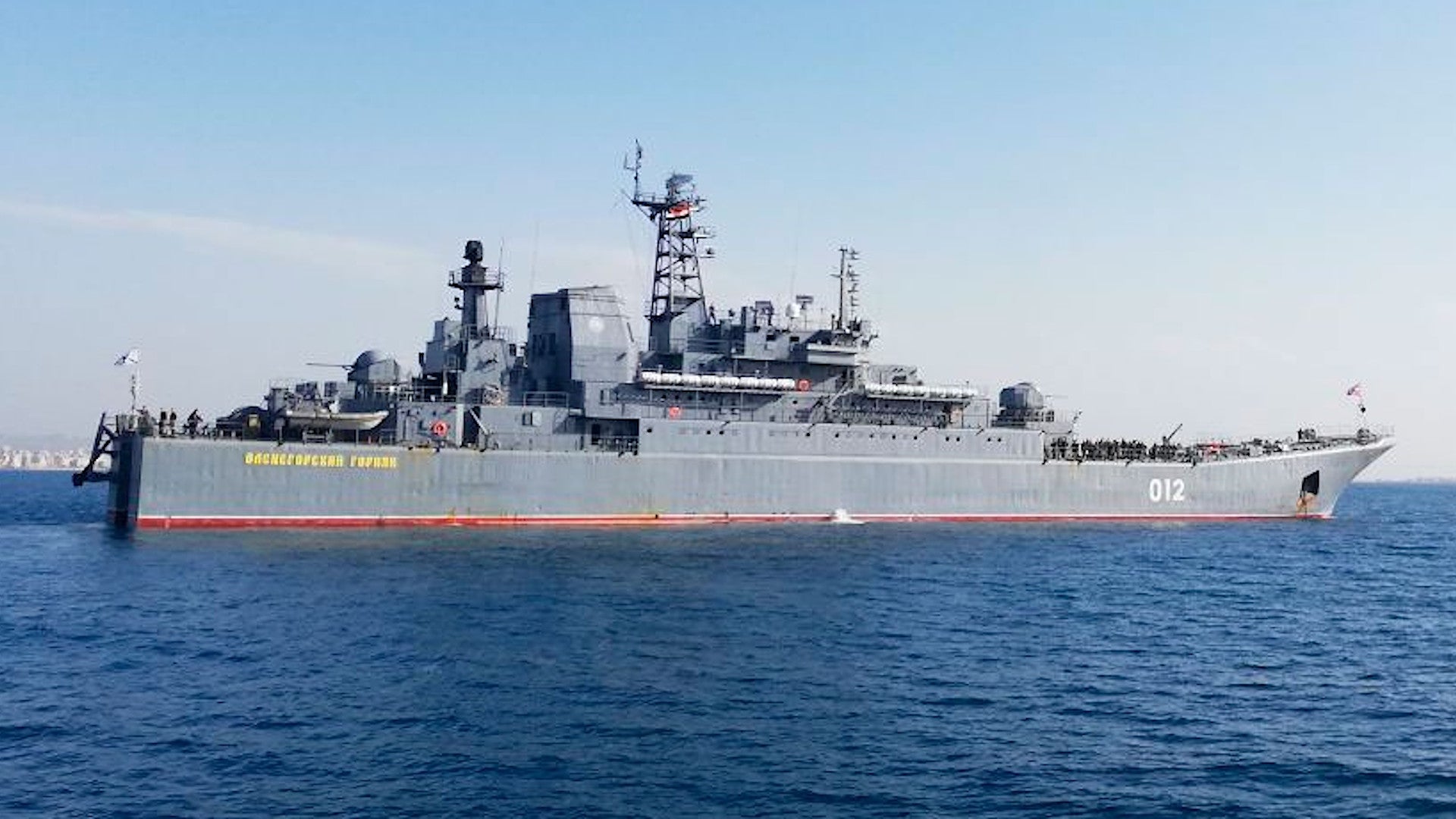Six Russian Navy amphibious warfare ships that departed the Baltic Sea region in January and entered the Mediterranean Sea last week are now in Syria. The vessels are resupplying at Russia’s naval facility in the Syrian port of Tartus, ostensibly ahead of a large maritime exercise that is set to kick off in the Mediterranean soon. However, there have been persistent discussions about whether these ships might be moving into a place where they could relatively quickly redeploy into the Black Sea to support a potential new Russian military incursion into Ukraine, and they are certainly better positioned for such a contingency now.
TV Zvezda, the Russian Ministry of Defense’s official television channel, reported the arrival of the six landing ships in Tartus earlier today. The flotilla is comprised of three Project 775 Ropucha class amphibious warfare ships from the Russian Navy’s Baltic fleet, as well as two more Ropuchas and the Project 11711
Ivan Gren class landing ship Pyotr Morgunov from that service’s Northern Fleet. It remains unclear if these vessels, which can carry significant numbers of armored vehicles and troops, as well as other cargo, have naval infantry units or other significant payloads inside their holds.
“Despite the stormy conditions, the ships and crew members showed their best maritime qualities, so the transition was very successful,” Fyodor Vinovozov, a Russian naval office serving as the deputy commander of this detachment of landing ships, told TV Zevada. Vinovozov was very likely referring to poor weather that reportedly slowed the progress of the ships as they left the Baltic Sea region last month.
Varyag, Udaloy class destroyer
Admiral Tributs, and the fleet oiler Boris Butoma, all from the Russian Navy’s Pacific Fleet, as well as the Vishnya class intelligence-gathering ship Vasiliy Tatishchev, are also in the Mediterranean Sea. Dozens of Russian naval vessels, as well as a significant number of aircraft, are deploying around the world for what the Kremlin says is a series of large-scale maritime drills.
Another group of Russian warships has sailed into an area of the Atlantic southwest of Ireland, where they are scheduled to conduct separate live-fire drills. The Slava class cruiser
Marshal Ustinov, the Udaloy class destroyer Vice-Admiral Kulakov, the Admiral Gorshkov class frigate
Admiral Kastanov, the fleet oiler Vyazma, and an ocean-going tug are expected to be among the participants. These forthcoming exercises have drawn criticism from the Irish government and Irish fishermen plan to gather in boats nearby in protest.
This all comes amid a continued Russian military buildup along many of its western borders, especially along its border with Ukraine, as well as in neighboring Belarus. The U.S. government, as well as representatives of other members of NATO and the alliance itself, have repeatedly expressed concerns about the lack of transparency about these deployments. This, in turn, has promoted persistent fears the Kremlin may be actually be staging forces, such as these six landing ships, to support a new, multi-pronged intervention into Ukraine.
“[Russian President Vladimir] Putin continues to add forces, combined arms, offensive capabilities – even over just the last 24 hours, he continues to add in western Russia and in Belarus, and again, as I said, in the Mediterranean and – and the North Atlantic,” Pentagon Press Secretary John Kirby said at a press conference on Feb. 2, 2022. “He has shown no signs of being interested or willing to deescalate the tensions.”
There has been a significant convergence of other naval forces in the Mediterranean recently, as well. The U.S. Navy’s aircraft carrier USS Harry S. Truman, its associated strike group, and other American and NATO forces are notably taking part in a major training exercise called Neptune Strike 22. The Pentagon had previously ordered the Truman Carrier Strike Group to remain in the region to help reassure allies and try to deter Russian aggression.
The U.S. government and other members of NATO are also in the process of sending other forces along the rest of the alliance’s periphery with Russia for the same general reasons. Just this week, the Pentagon announced that 3,000 members of the U.S. Army would deploy to various locations in Europe as part of these larger force posture changes.
U.S. and other Western officials, as well as those in Ukraine, continue to stress that a new Russian invasion of Ukrainian territory is not inevitable, nor is it necessarily imminent, despite the Kremlin’s worrying movements of forces in and around Europe. It remains to be seen if the six landing ships now in Syria ultimately move into the Black Sea for any reason.
Separately, the arrival of the ships in Tartus simply underscores the strategic significance of Russia’s outpost there, which is the country’s only warm water naval facility outside of the Black Sea and exists specifically to support these kinds of deployments. The Russian Navy’s base in Syria dates back to the Soviet era, but it has seen significant expansion since the Kremlin decided to intervene in the country on behalf of its dictator Bashar Al Assad in 2015. TV Zvezda’s report on the arrival of the landing ships highlights the work that has been done to increase the base’s overall capacity to conduct maintenance and other support functions for ships in the region.
In 2017, Putin signed a new deal with Assad’s regime to lease the base in Tartus for another 49 years, with built-in provisions to negotiate further 25-year-long extensions afterward.
Only time will tell how Russia’s naval activities in the Mediterranean, and their potential relationship to the crisis surrounding Ukraine, ultimately evolve. However, Kremlin clearly intends for them to be at least a general show of force and demonstration of its force projection capabilities, as evidenced by the long-distance deployment of the six landing ships to the region, which is now making use of the support capacity available at the Russian Navy’s strategic base in Syria.
Contact the author: joe@thedrive.com
